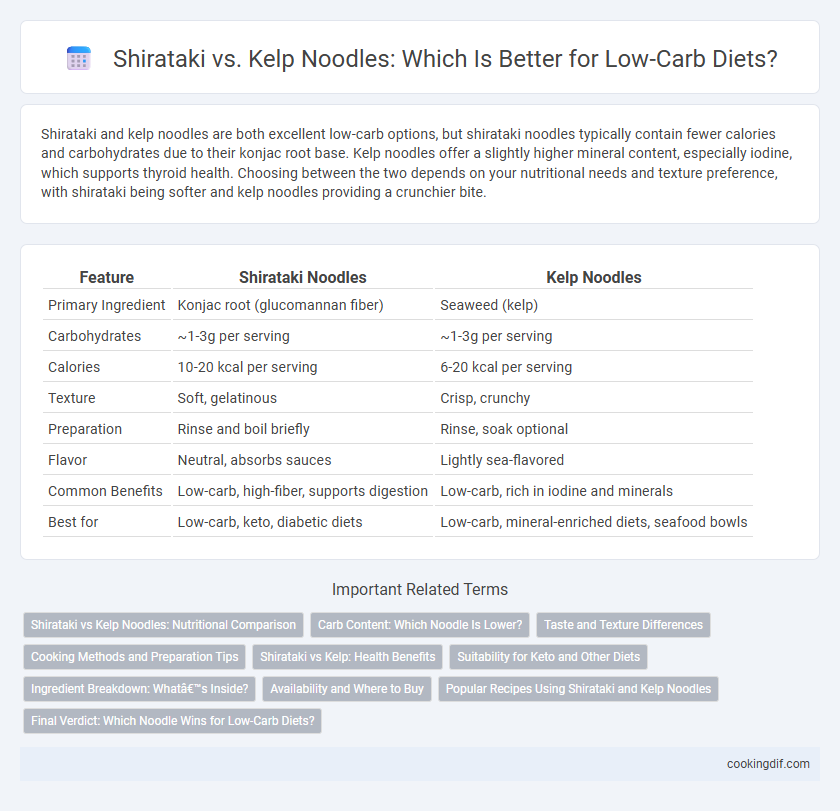Shirataki and kelp noodles are both excellent low-carb options, but shirataki noodles typically contain fewer calories and carbohydrates due to their konjac root base. Kelp noodles offer a slightly higher mineral content, especially iodine, which supports thyroid health. Choosing between the two depends on your nutritional needs and texture preference, with shirataki being softer and kelp noodles providing a crunchier bite.
Table of Comparison
| Feature | Shirataki Noodles | Kelp Noodles |
|---|---|---|
| Primary Ingredient | Konjac root (glucomannan fiber) | Seaweed (kelp) |
| Carbohydrates | ~1-3g per serving | ~1-3g per serving |
| Calories | 10-20 kcal per serving | 6-20 kcal per serving |
| Texture | Soft, gelatinous | Crisp, crunchy |
| Preparation | Rinse and boil briefly | Rinse, soak optional |
| Flavor | Neutral, absorbs sauces | Lightly sea-flavored |
| Common Benefits | Low-carb, high-fiber, supports digestion | Low-carb, rich in iodine and minerals |
| Best for | Low-carb, keto, diabetic diets | Low-carb, mineral-enriched diets, seafood bowls |
Shirataki vs Kelp Noodles: Nutritional Comparison
Shirataki noodles contain about 3 grams of carbohydrates per serving with high fiber content, making them ideal for low-carb diets, while kelp noodles have slightly higher carbs, approximately 5 grams per serving, but are rich in iodine and minerals from seaweed. Shirataki's glucomannan fiber promotes digestion and blood sugar control more effectively compared to kelp noodles. Both options offer low-calorie alternatives to traditional pasta, but Shirataki's near-zero net carbs make it a superior choice for strict low-carb and ketogenic diets.
Carb Content: Which Noodle Is Lower?
Shirataki noodles contain approximately 1-3 grams of net carbs per serving, making them exceptionally low in carbohydrates and ideal for strict low-carb diets. Kelp noodles typically have slightly higher carb content, around 3-6 grams per serving, due to their seaweed-based composition. For those prioritizing the lowest carb intake, shirataki noodles offer a more favorable option compared to kelp noodles.
Taste and Texture Differences
Shirataki noodles offer a translucent, gelatinous texture with a subtle, neutral taste that easily absorbs surrounding flavors, making them ideal for low-carb diets requiring noodle substitutes. Kelp noodles have a crisp, crunchy texture and a slightly salty, oceanic flavor that provides a distinct bite and freshness in dishes. Both types are low in carbs and calories, but choice depends on whether a softer or more textured noodle experience is desired.
Cooking Methods and Preparation Tips
Shirataki noodles require thorough rinsing and boiling for 1-2 minutes to remove their natural odor and improve texture, making them ideal for stir-frying or adding to soups. Kelp noodles need only a quick rinse and can be eaten raw or lightly blanched, offering a crisp texture that works well in salads and cold dishes. Both noodle types benefit from marinating or seasoning after cooking to enhance their mild flavors while supporting low-carb dietary goals.
Shirataki vs Kelp: Health Benefits
Shirataki noodles are rich in glucomannan fiber, which supports digestive health and promotes satiety, making them ideal for low-carb diets. Kelp noodles provide a unique source of iodine and trace minerals that support thyroid function and metabolism. Both offer low-calorie, gluten-free options, but Shirataki is often preferred for its higher fiber content and stronger impact on blood sugar regulation.
Suitability for Keto and Other Diets
Shirataki noodles, made from konjac yam, contain virtually zero carbohydrates and are ideal for strict keto and low-carb diets, providing minimal impact on blood sugar levels. Kelp noodles, derived from seaweed, offer a slightly higher carbohydrate content but supply essential minerals like iodine, making them suitable for paleo, vegetarian, and gluten-free diets. Both noodle types support weight management and digestive health while fitting various dietary restrictions depending on individual macro goals.
Ingredient Breakdown: What’s Inside?
Shirataki noodles are primarily made from glucomannan, a soluble fiber derived from the konjac root, resulting in a low-calorie, low-carb option with minimal digestible carbohydrates. Kelp noodles consist mainly of kelp seaweed, providing essential minerals like iodine and calcium, along with low carbohydrate content but higher fiber compared to shirataki. Both noodle types are excellent choices for low-carb diets, with shirataki offering more fiber and gel-like texture, while kelp noodles deliver added micronutrients from seaweed.
Availability and Where to Buy
Shirataki noodles, made from konjac yam, are widely available in most grocery stores and online retailers specializing in low-carb and keto products, making them an accessible option for low-carb diets. Kelp noodles, derived from seaweed, can be found primarily in health food stores, Asian markets, and specialty online shops, often with more limited availability compared to shirataki. Both types offer low-carb alternatives, but shirataki's broader distribution ensures easier purchase for those following ketogenic or low-carb meal plans.
Popular Recipes Using Shirataki and Kelp Noodles
Shirataki noodles, made from glucomannan yam, are celebrated for their ultra-low-carb content and ability to absorb flavors, making them ideal in stir-fries, soups, and keto-friendly pasta dishes. Kelp noodles, derived from seaweed, provide a crunchy texture and are often featured in raw salads, Asian-inspired spring rolls, and chilled noodle bowls, offering a refreshing contrast to cooked meals. Both noodles serve as versatile, nutrient-rich alternatives in popular low-carb recipes, enhancing dietary variety without compromising taste or texture.
Final Verdict: Which Noodle Wins for Low-Carb Diets?
Shirataki noodles, made from konjac yam, contain virtually zero carbs and are rich in glucomannan fiber, making them ideal for strict low-carb diets. Kelp noodles, derived from seaweed, have a slightly higher carb content but offer additional minerals such as iodine and calcium. For the most effective carb reduction and digestive benefits on a low-carb diet, shirataki noodles are the superior choice.
Shirataki vs Kelp Noodles for low-carb diets Infographic

 cookingdif.com
cookingdif.com